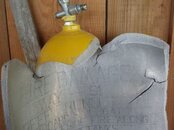The only regs I know of are the hazmat regs. According to my references (I'm reading from documents procured at my last PSI VCI class), cylinders containing compressed gases over 40 psi are considered hazardous materials. If you are commercially transporting over 1000 pounds of compressed gas cylinders (counting the cylinders and their contents), you must have the appropriate documents (licensed hazmat transport operator), the cylinders must be secured in an upright position, the vehicle must be placarded, you can have no passengers.
If you're commercially transporting *any* quantity of cylinders containing gases at 40 psi or greater (including scuba cylinders, emergency oxygen, etc.), you *must* have a manifest on board as to what is being carried. (This applies to dive shops, instructors, or pretty much anyone but a lone, unconnected diver.)
Sadly, I am unable to spend the time reading 49CFR172 and so on in order to provide actual references, however, it seems apparent that if you're not commercially transporting, you're pretty much in the clear. On the other hand, if you have over 1000 pounds of compressed gas cylinders (what is that, almost 30 AL80s?) and you get stopped, you're going to have a hard time arguing that they are for personal use only. (Ha! For once, your logbook might actually come in handy!

)





